Interesting Facts About Cherokee Culture You Never Knew
You might be surprised to learn that Cherokee culture is rich with fascinating traditions you've never encountered. Did you know they have seven distinct clans, each with unique roles in society? Their storytelling traditions feature mythical beings like thunder spirits and giant birds, preserving oral history through generations. The Cherokee language, with its unique syllabary, once boasted impressive literacy rates. Traditional medicine people practice holistic healing without charging fees, while artisans create intricate baskets, pottery, and beadwork. The cuisine centers around the "Three Sisters" – corn, beans, and squash. These aspects only scratch the surface of this complex and vibrant culture.
This post may contain affiliate links. If you make a purchase through these links, I may earn a commission at no additional cost to you. Additionally, portions of this post may be generated using artificial intelligence (AI) technology. While we strive for accuracy, please be aware that AI-generated content may not always be perfect and should be fact-checked when necessary.
The Spatula Scoops
- Cherokee society is matrilineal, with clan membership and inheritance passed through mothers.
- The Cherokee language has its own syllabary, invented by Sequoyah in 1821.
- Traditional Cherokee cuisine centers around the "Three Sisters": corn, beans, and squash.
- Cherokee storytelling features mythical beings like Uktena, a fearsome dragon-like creature.
- The Cherokee produced the first Native American newspaper, called the Cherokee Phoenix.
The Seven Cherokee Clans
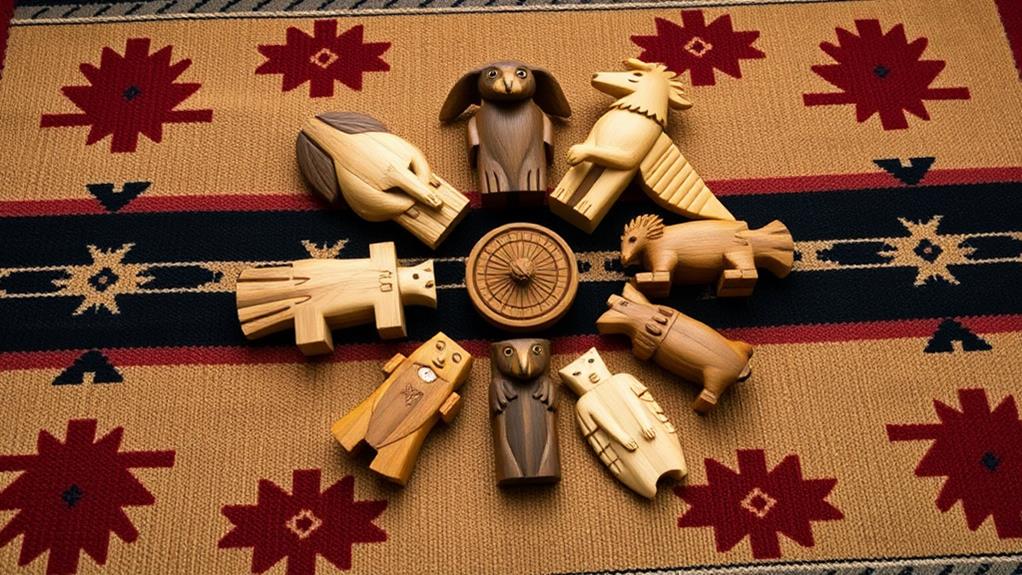
The Cherokee clan system forms the backbone of their traditional social structure. You might be surprised to learn that there are seven Cherokee clans, each with distinct roles and responsibilities within their society. These clans are A-ni-gi-lo-hi (Long Hair), A-ni-sa-ho-ni (Blue), A-ni-wa-ya (Wolf), A-ni-go-te-ge-wi (Wild Potato), A-ni-a-wi (Deer), A-ni-tsi-s-qua (Bird), and A-ni-wo-di (Paint).
What's particularly interesting is that Cherokee clans function as matrilineal units, meaning lineage is traced through the mother's side. This emphasizes the importance of clan mothers in decision-making and justice within the community. The A-ni-wa-ya clan, or Wolf clan, historically served as warriors, playing an essential role in defending the Cherokee people.
Clan membership greatly influences social interactions and responsibilities. If you were a Cherokee, you'd be expected to uphold the values and traditions associated with your clan. This system helps maintain social cohesion and fosters a strong sense of identity and belonging among Cherokee people. By preserving these clan structures, the Cherokee continue to honor their rich cultural heritage and maintain their unique social fabric.
Cherokee Storytelling Traditions
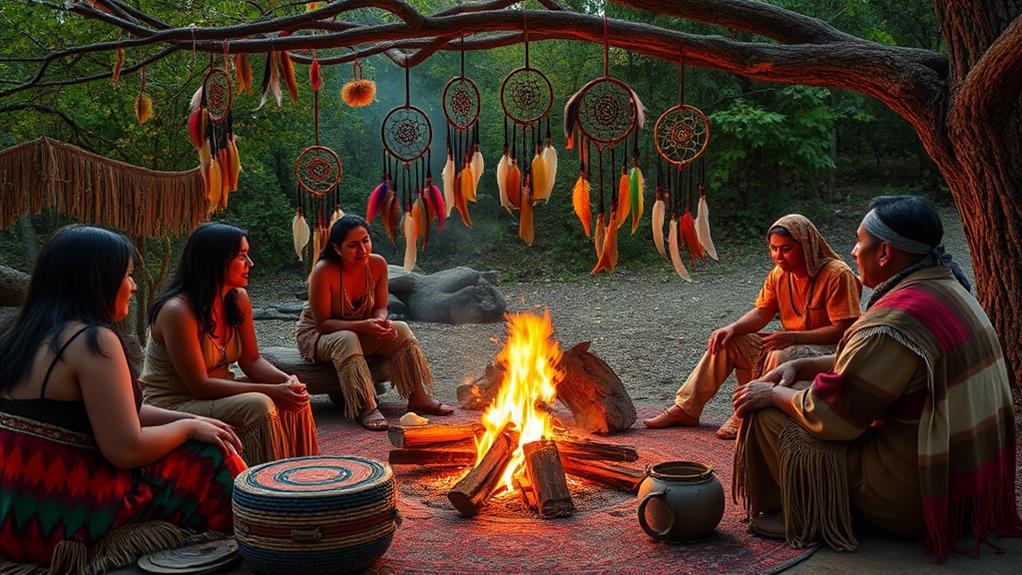
You'll find that Cherokee storytelling traditions are a cornerstone of their culture, serving as a crucial method for preserving oral history. These stories often feature mythical creatures like the Aniyvdaqualosgi (Thunder spirits) and Jistu (the rabbit), whose tales captivate listeners while imparting important moral lessons. Through these narratives, you'll discover how the Cherokee people have passed down their values, beliefs, and cultural wisdom from generation to generation, ensuring the continuity of their rich heritage.
Oral History Preservation
How do the Cherokee keep their history alive without written records? The answer lies in their rich oral tradition. Cherokee storytelling traditions form the backbone of their oral history preservation, passing down cultural values, historical knowledge, and moral lessons from generation to generation.
You'll find that elders play an essential role in this process. They're respected as the keepers of wisdom and experience, sharing stories during community gatherings and ceremonial events. These storytelling sessions aren't just entertaining; they're fundamental for maintaining social cohesion and cultural heritage.
The stories often feature legendary figures and mythical beings, like thunder spirits and the clever rabbit, which embody important Cherokee beliefs. To make these tales memorable, storytellers use rhythm and repetition techniques. This approach helps listeners, especially younger generations, retain the information more easily.
Mythical Creature Tales
Central to Cherokee storytelling traditions are the enchanting tales of mythical creatures. You'll find a rich tapestry of legends featuring powerful beings that have captivated generations. Let's explore some of these fascinating creatures:
| Creature | Description |
|---|---|
| Aniyvdaqualosgi | Thunder spirits commanding storms |
| Jistu | Clever rabbit outsmarting others |
| Nunnehi | Friendly spirits assisting Cherokee |
| Uktena | Fearsome dragon-like entity |
| Tlanuwa | Giant birds with metal feathers |
These mythical creatures play significant roles in Cherokee storytelling. You'll encounter Aniyvdaqualosgi, the thunder spirits believed to control thunderstorms and lightning. Jistu, the cunning rabbit, often outsmarts larger animals and humans in tales that teach valuable lessons. The Nunnehi are benevolent spirits who come to the Cherokee's aid during challenging times, embodying themes of bravery and support. Uktena, a terrifying dragon-like creature, appears in stories where heroes must confront and defeat it to protect their communities. Finally, the Tlanuwa, enormous birds of prey with impenetrable metal feathers, symbolize power and protection in Cherokee legends, reinforcing cultural themes of strength and resilience.
Moral Lessons Conveyed
Cherokee storytelling traditions are rich with moral lessons that guide listeners toward ethical living and cultural understanding. You'll find that these tales often feature animal characters like the clever rabbit, Jistu, who embodies resourcefulness and wit while imparting valuable teachings. As you investigate Cherokee traditions, you'll discover that stories about creation and supernatural beings, such as the Thunder spirits, instill a deep sense of responsibility toward the natural world and unseen forces.
These narratives serve as powerful tools for spiritual guidance, reinforcing the importance of community and respect for nature. When you attend Cherokee gatherings or ceremonies, you'll witness how storytelling traditions play a pivotal role in educating younger generations about their heritage and identity. The moral lessons conveyed through these stories emphasize the intricate relationships between humans, nature, and the spiritual domain. You'll learn that Cherokee culture values wisdom, humility, and harmonious living. By exploring these storytelling traditions, you'll gain insight into the Cherokee worldview and the ethical principles that have shaped their society for generations.
Unique Cherokee Language Features

What makes the Cherokee language stand out among Indigenous tongues? You'll find that this Iroquoian language has a unique tonal structure, setting it apart from many other Native American languages. It's characterized by distinct sounds and grammatical rules, lacking common consonants found in European languages.
In 1821, Sequoyah developed the Cherokee syllabary, a writing system that revolutionized literacy rates among the Cherokee people. This innovation led to the creation of the Cherokee Phoenix, the first Native American newspaper. It's a representation of the language's adaptability and the Cherokee people's commitment to preserving their cultural identity.
Today, preservation efforts are vital as fewer than 1,000 individuals speak Cherokee as their first language. Tribal-operated schools are implementing initiatives to revitalize its use among younger generations. These efforts are essential for maintaining the Cherokee people's rich heritage and linguistic traditions.
Understanding the unique features of the Cherokee language provides insight into the complexity and beauty of Indigenous cultures. It's a reminder of the importance of language preservation in maintaining cultural diversity and identity.
Traditional Cherokee Medicinal Practices
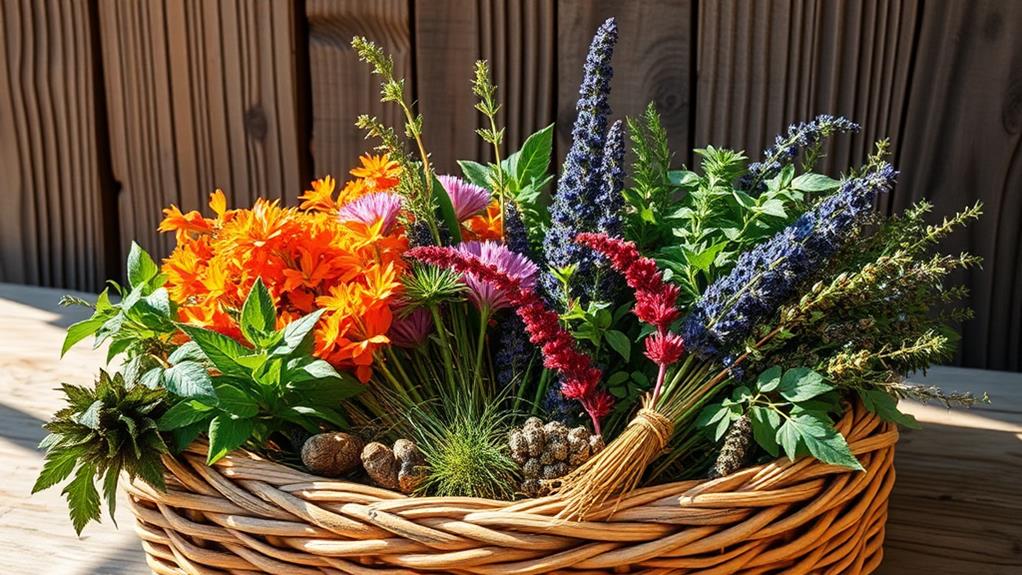
In Cherokee culture, medicine people play an essential role in treating both physical and spiritual ailments. You'll find that authentic healing practices are deeply rooted in community connections, with legitimate practitioners typically approached through established relationships rather than direct requests for service. These traditional healers combine their extensive knowledge of local natural resources with integrated rituals, emphasizing a holistic approach that blends physical treatment with spiritual guidance and community support.
Medicine People's Role
Traditional medicine people hold a revered position in Cherokee culture, serving as both healers and spiritual guides. These individuals possess extensive knowledge of herbal remedies and cultural practices, which they use to address both physical and spiritual ailments. You'll find that medicine people don't typically charge for their services, as their role is deeply rooted in community connections and familial relationships.
Unfortunately, the number of active medicine people has declined in recent years, making it essential to preserve their traditional knowledge. If you're seeking a legitimate healer, it's important to approach the process through community ties rather than direct requests to the Cherokee Nation.
| Aspect | Traditional Medicine People | Fraudulent Practitioners |
|---|---|---|
| Fees | Don't charge | Often charge for services |
| Knowledge | Extensive herbal and cultural | Limited or false claims |
| Approach | Holistic healing | Focus on profit |
| Community Role | Deeply connected | Often outsiders |
| Authenticity | Recognized by community | Self-proclaimed |
Cherokee healing practices emphasize the interconnectedness of all living beings and respect for nature. These ceremonies and rituals highlight the importance of spiritual well-being alongside physical health. Be aware that misrepresentation of traditional medicine roles exists, so it's essential to approach these practices with cultural respect and vigilance.
Authentic Healing Practices
Cherokee healing traditions encompass a rich tapestry of practices rooted in ancestral wisdom and natural harmony. You'll find that authentic Cherokee medicine is deeply intertwined with the community's respect for Earth's elements and spiritual well-being. Traditional remedies often involve consultations with medicine people, who draw upon generations of ancestral knowledge to address health concerns and life issues.
It's important to understand that legitimate healing practices don't come with a price tag for ceremonies. If you're seeking help, it's best to approach recognized practitioners through community connections rather than direct requests. You'll notice that many of these healing methods are kept private, reflecting the Cherokee's commitment to preserving their cultural beliefs.
In recent years, the number of active medicine people has decreased, with knowledge being shared informally through community ties. This shift has made it even more essential to respect the authenticity of these practices. Remember, Cherokee healing emphasizes harmony with nature, utilizing plants and rituals to restore balance. By understanding these aspects, you'll gain a deeper appreciation for the complexity and significance of Cherokee medicine within their culture.
Cherokee Art and Craftsmanship
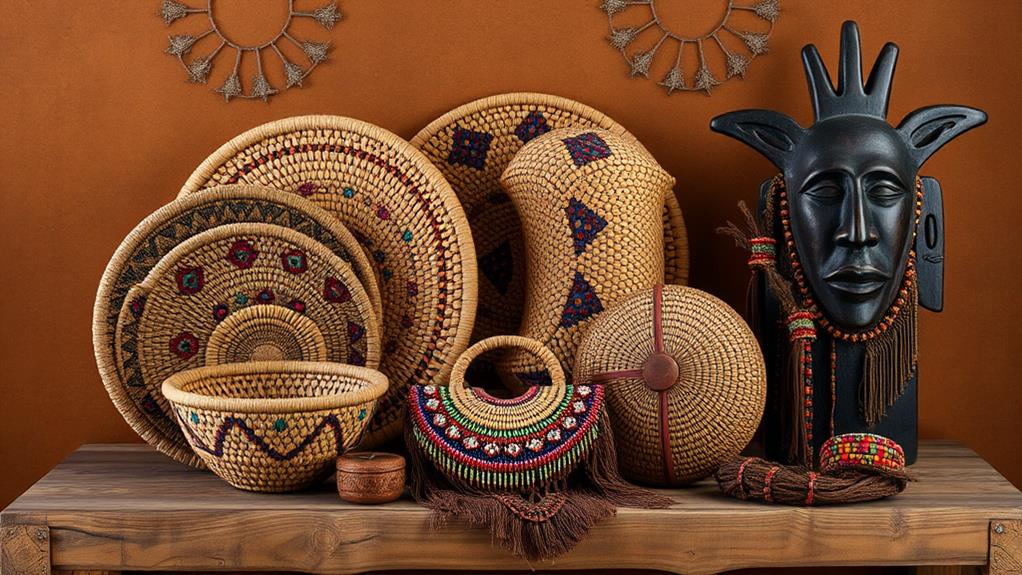
Numerous forms of artistic expression showcase the rich cultural heritage of the Cherokee people. You'll find Cherokee art characterized by intricate patterns and designs, particularly evident in traditional basket-weaving. Artists skillfully use natural materials like rivercane, honeysuckle, and white oak to create these masterpieces.
Pottery is another essential aspect of Cherokee craftsmanship. Both functional and decorative pieces often feature unique motifs that reflect the tribe's history. You'll be amazed by the vibrant colors and geometric patterns in Cherokee beadwork, which creates stunning wearable art with deep cultural significance.
Don't overlook finger-weaving, a traditional craft used to produce sashes and belts with symbolic designs. The art of carving remains highly respected, with artists creating intricate wooden sculptures, masks, and totems that tell ancestral stories and explore contemporary themes.
As you explore Cherokee art, you'll discover a rich tapestry of skills and traditions. Each piece not only demonstrates remarkable craftsmanship but also serves as an indication of the enduring cultural heritage of the Cherokee people. These art forms continue to evolve while maintaining their deep-rooted connections to history and community.
Ancient Cherokee Social Structure
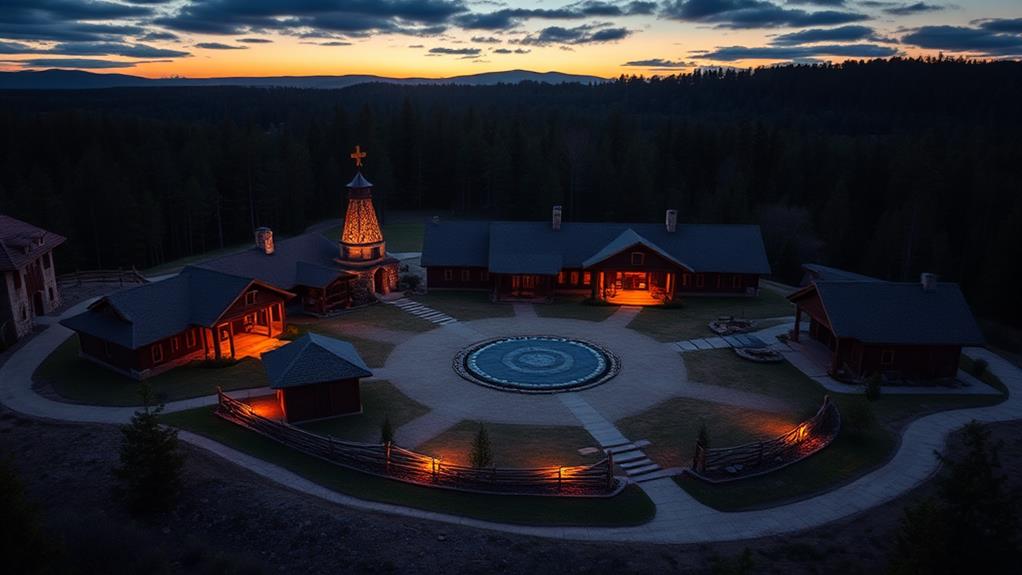
Beyond the artistic expressions of Cherokee culture lies a complex social structure that has shaped their society for centuries. You'll find that Cherokee society is organized into seven distinct clans, each playing an essential role in community governance and social cohesion. This clan system is matrilineal, meaning clan membership is passed down through the mother's line.
At the heart of this structure are the clan mothers, who wield significant power in administering justice and community affairs. The table below outlines the seven clans and their traditional roles:
| Clan Name | Primary Role |
|---|---|
| Long Hair | Peacemakers, Diplomats |
| Blue | Healers, Medicine |
| Wolf | Warriors, Defense |
| Wild Potato | Gatherers, Agriculture |
This structure promotes balance and equality between genders, with both men and women holding respected positions. Decision-making often involves a council of leaders from different clans, ensuring diverse representation. The clan system not only maintains social order but also reinforces cultural identity, with each clan contributing uniquely to the community's well-being and governance.
Cherokee Spiritual Beliefs
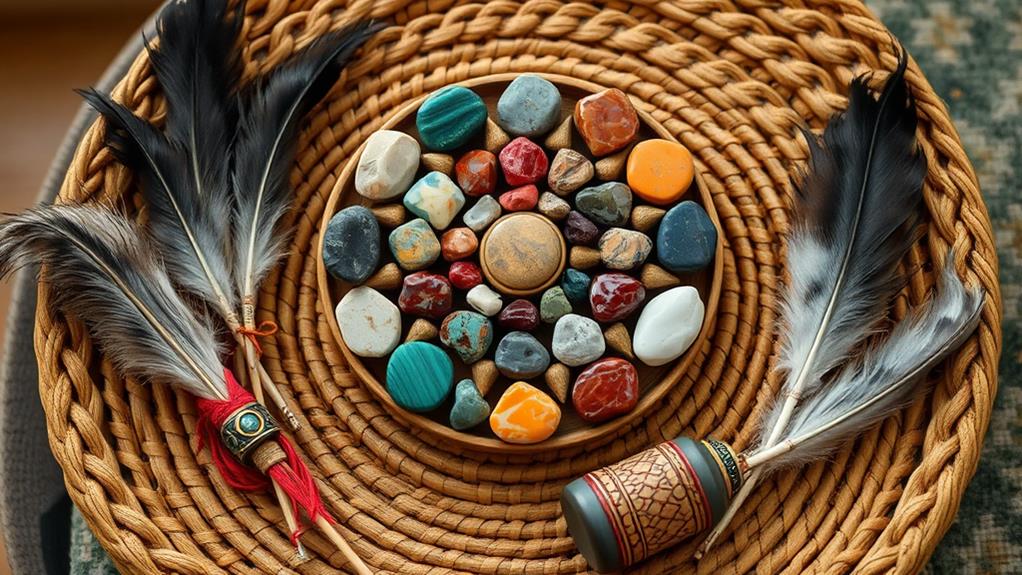
At the heart of Cherokee spirituality lies a profound connection to nature, where every element holds sacred significance. You'll find that Cherokee spiritual beliefs center around Unetlanvhi, the Great Spirit, who guides and influences their practices. This reverence for the natural world is evident in their traditional ceremonies, such as the Green Corn Ceremony and "going to water" rituals, which emphasize purification and gratitude.
The Cherokee recognize various spiritual beings, including:
- The friendly Nunnehi, believed to aid the Cherokee people
- Thunder spirits, known as Aniyvdaqualosgi, who command thunder and lightning
- The Great Spirit, Unetlanvhi, central to their belief system
Oral traditions play an essential role in preserving Cherokee cultural identity and passing down spiritual beliefs. Through storytelling, the Cherokee maintain their connection to their ancestors and provide moral guidance to future generations. These narratives serve as an important link between the past and present, ensuring the continuity of their rich spiritual heritage. By understanding these aspects of Cherokee spirituality, you'll gain insight into the depth and complexity of their cultural practices.
Traditional Cherokee Cuisine

Traditional Cherokee cuisine centers around three key ingredients: corn, beans, and squash, collectively known as the "Three Sisters." You'll find these staples at the heart of many dishes, reflecting the tribe's deep-rooted agricultural practices. Beyond these foundational elements, the Cherokee Nation of Oklahoma's traditional diet incorporates a variety of local ingredients, showcasing the bounty of their ancestral lands.
You might be surprised to learn that crawdads, wild onions, and hog meat are popular in Cherokee cooking. Fried fish, brown beans, and poke sallet also feature prominently in their cuisine. For those with a sweet tooth, grape dumplings and kanutsi (a type of pudding) are cherished desserts often enjoyed during community gatherings.
It's important to note that while fry bread and Indian tacos are widely recognized, they're not considered traditional Cherokee foods. Instead, they're modern adaptations that have gained popularity over time. Traditional cuisine plays a vital role in preserving Cherokee cultural heritage, with dishes being celebrated at family and community events. These culinary traditions help reinforce social bonds and keep ancient practices alive in the modern world.
Are There Any Cultural Similarities Between the Cherokee and Kazakhstan Traditions?
Both the Cherokee and Kazakhstan traditions emphasize a deep connection to nature, family values, and storytelling as a means of preserving history. Exploring these shared traits offers insight into their rich cultures, with interesting facts about kazakhstan revealed through its nomadic heritage, similar to the Cherokee’s respect for ancestral ways and communal life.
Cherokee Music and Dance
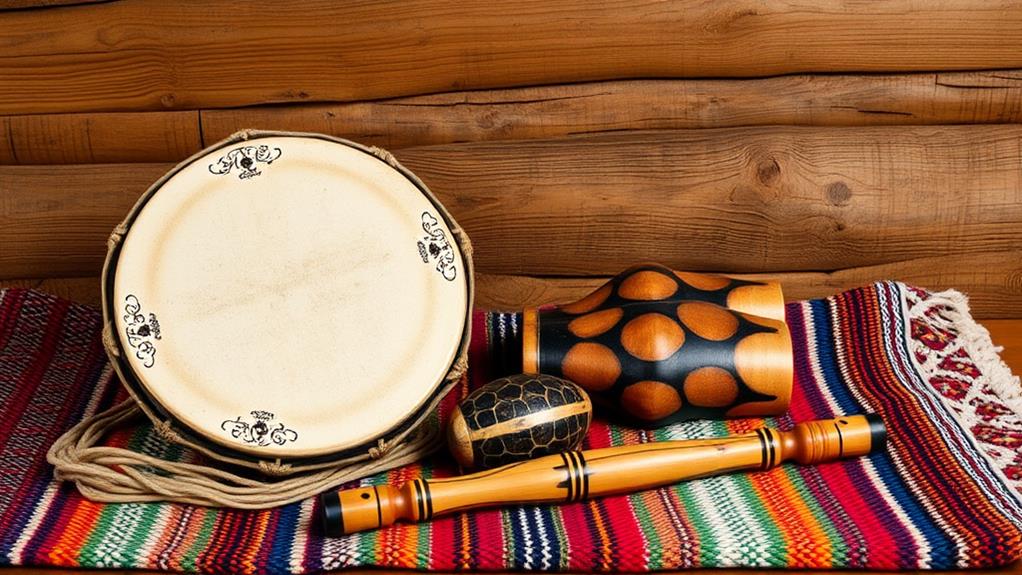
Cherokee culture resonates not only through food but also in the vibrant rhythms and movements of their music and dance. You'll find that Cherokee music is a blend of traditional and modern influences, with instruments ranging from flutes and drums to fiddles and guitars. This musical evolution reflects the tribe's rich cultural heritage and adaptability over time.
The significance of music and dance in Cherokee culture can't be overstated. They serve multiple purposes:
- Preserving tribal stories and history
- Enhancing rituals and community celebrations
- Expressing identity and fostering communal bonds
Traditional dances, such as the Bear Dance and Friendship Dance, are integral to Cherokee cultural expression. The Warriors of AniKituhwa, a cultural ambassador group, plays a vital role in reviving traditional dances like the War Dance and Eagle Dance.
You might be surprised to learn that Cherokee music has been influenced by 18th-century English and Scottish fiddle playing, as well as African musical traditions. This diverse musical heritage has resulted in a vibrant and unique sound that continues to evolve while maintaining its cultural roots.
Frequently Asked Questions
What Are Some Cool Facts About the Cherokee Tribe?
You'll be fascinated to learn that the Cherokee developed their own writing system, called the Cherokee syllabary, in 1821. This innovation led to the creation of the first Native American newspaper, the Cherokee Phoenix, in 1828. The tribe's society is organized into seven matriarchal clans, each with specific roles. Their language, classified as Iroquoian, has a unique tonal structure. The annual Green Corn Festival celebrates the harvest and reinforces their spiritual connection to the land.
What Is the Cherokee Culture Known For?
You'll find that Cherokee culture is known for its rich traditions and unique social structure. They're recognized for their matrilineal society, where women play vital roles in governance. You'll be impressed by their distinctive syllabary, developed by Sequoyah, which boosted literacy rates. Their traditional dome-shaped winter homes and open-air summer dwellings showcase their environmental adaptability. You'll also appreciate their significant Green Corn Ceremony and their renowned craftsmanship in basketry, pottery, and beadwork, which reflect both historical and contemporary cultural expressions.
What Are Some Interesting Facts About the Cherokee Language?
Like a phoenix rising from ashes, the Cherokee language stands as a symbol of resilience. You'll find it fascinating that Sequoyah's syllabary, created in 1821, revolutionized Cherokee literacy. It's a tonal language with unique grammatical structures, setting it apart from other Indigenous tongues. Sadly, there are fewer than 1,000 fluent speakers today. You might be surprised to learn that "Aho" isn't an authentic Cherokee greeting—it's actually considered offensive. Tribal schools are now actively working to preserve this rich linguistic heritage.
What Are Unique Characteristics of the Cherokee?
You'll find the Cherokee have several unique characteristics. They're known for their matrilineal clan system, where lineage and inheritance pass through the mother's line. Their language is distinctive, using a syllabary rather than an alphabet. You'll notice their strong connection to nature in their arts and oral traditions. The Cherokee's adaptability is evident in their architectural evolution from wattle and daub to log cabins. Their emphasis on gender equality, particularly the role of clan mothers in administering justice, sets them apart from many other cultures.





